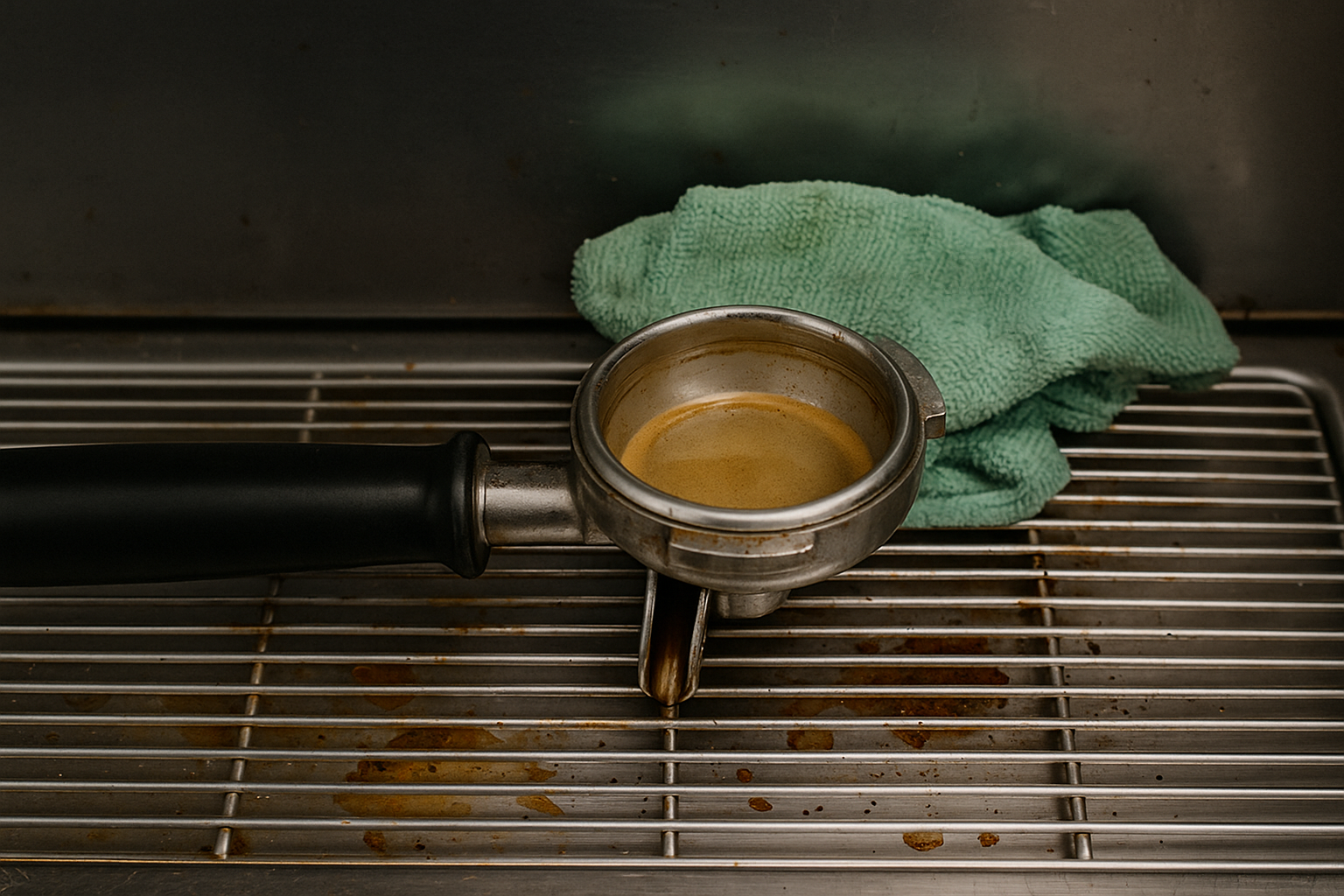As a barista, you’re not just making coffee — you’re working in a food-safe environment where cleanliness is non-negotiable.
While latte art and espresso shots often steal the spotlight, hygiene behind the bar is just as important. In fact, poor hygiene can lead to bad reviews, customer complaints, or even job loss.
Many beginner baristas unknowingly make hygiene mistakes that can damage a café’s reputation — and their own. In this article, we’ll break down the most common hygiene errors in a coffee bar and how to avoid them.
If you take your career seriously, you need to take hygiene seriously, too.
Why Hygiene Matters in a Coffee Bar
Even if you’re not cooking food, you’re working with milk, coffee, water, and equipment that customers rely on to be clean. Poor hygiene doesn’t just affect flavor — it can lead to:
- Foodborne illness
- Cross-contamination
- Health inspection violations
- Lost customer trust
- Termination from your job
Cleanliness shows professionalism and care. A messy bar suggests laziness — and no customer wants their drink made by someone who cuts corners on hygiene.
Mistake #1: Using the Same Cloth for Everything
One of the most dangerous habits new baristas develop is using a single cloth for multiple purposes. It’s fast and convenient — but also a recipe for cross-contamination.
What goes wrong:
- Wiping the steam wand, counters, and spills with the same rag spreads milk, bacteria, and grime.
- It creates an invisible but dangerous layer of buildup.
- It violates health codes in many regions.
What to do instead:
- Use separate cloths for:
- Steam wand
- Countertops
- Spills on the floor
- Equipment and portafilters
- Color-code your cloths if possible.
- Replace and wash them regularly throughout the day.
If you’re unsure which cloth to use, ask your manager — and when in doubt, use a clean one.
Mistake #2: Not Washing Hands Often Enough
Baristas touch money, machines, milk cartons, grinders, dishes, and more — all within minutes. Failing to wash your hands regularly introduces germs into everything you serve.
When you should wash your hands:
- After handling cash or using your phone
- After cleaning or throwing away trash
- After touching your face or hair
- Before preparing any drink
- After eating or drinking
- After sneezing or coughing
Tips:
- Keep hand sanitizer nearby, but don’t rely on it alone.
- Use warm water and soap for at least 20 seconds.
- Dry your hands with clean paper towels or a hand dryer — not on your apron.
Frequent handwashing is one of the simplest ways to stay professional and safe.
Mistake #3: Letting Milk Sit Out Too Long
Milk safety is no joke. Leaving milk jugs out of the fridge, steaming warm milk, or reusing old milk are all common beginner mistakes — and all are health hazards.
What happens when milk sits out:
- Bacteria grows quickly, even within 30 minutes.
- It curdles faster when steamed.
- It causes upset stomachs and potential illness.
What to do instead:
- Keep milk refrigerated at or below 4°C (39°F).
- Only take out what you need for the next few drinks.
- Never re-steam or reuse milk.
- Label open jugs with date and time, if your café requires it.
Respecting milk safety is key in every shift.
Mistake #4: Not Cleaning Tools Between Uses
Your portafilter, tamper, milk pitchers, and other tools must be cleaned regularly. Even if you’re busy, skipping this step leads to contamination and flavor issues.
Examples:
- A portafilter with old grinds affects the taste of every new shot.
- A milk pitcher with dried residue can ruin foam quality.
- Tampers left on dirty counters carry bacteria.
What to do:
- Rinse and wipe the portafilter after each use.
- Rinse milk pitchers immediately after steaming.
- Clean tampers and rest them on a clean mat or towel.
- Disinfect shared tools (like thermometers or spoons) throughout the day.
Clean tools = clean drinks. It’s that simple.
Mistake #5: Letting Garbage and Dishes Pile Up
Overflowing trash bins, dirty towels, and stacks of unwashed dishes send a clear message: “We don’t care.” Customers see this, and so do managers.
What goes wrong:
- Strong odors develop quickly.
- Fruit flies and pests are attracted.
- Workstations become cluttered and dangerous.
- Health inspectors flag these issues immediately.
What to do instead:
- Take out trash regularly, even if it’s not completely full.
- Rinse dishes and stack them neatly if you can’t wash them right away.
- Keep your workstation organized, with dirty towels in a designated bin.
- Spray and wipe surfaces frequently throughout the shift.
A clean space is safer, more efficient, and way more pleasant to work in.
Mistake #6: Touching the Rim of Cups or Lids
This may seem small, but it’s a critical hygiene rule in food service. When you grab a cup or lid by the part that touches a customer’s mouth, it’s an instant red flag.
What’s wrong:
- You transfer bacteria from your hands directly to the customer.
- It looks unprofessional and careless.
- It’s a major hygiene violation in most cafés.
What to do instead:
- Hold cups from the base or sides, never the rim.
- Pick up lids by the edge or use tongs, if available.
- Train your muscle memory to handle everything cleanly and efficiently.
Customers notice — and appreciate — these small hygiene details.
Mistake #7: Ignoring End-of-Shift Cleaning Duties
Many beginner baristas focus during rushes but drop the ball during close. However, closing duties are what set up the next day for success — and prove your reliability to your team.
Common closing mistakes:
- Skipping grinder cleaning
- Not backflushing the espresso machine
- Leaving dirty cloths and milk pitchers
- Forgetting to wipe down surfaces and fridges
What to do instead:
- Follow the café’s cleaning checklist thoroughly.
- Double-check everything — especially hard-to-see areas.
- Work as a team and communicate to avoid overlap or missed tasks.
- Take pride in leaving the bar better than you found it.
Managers love baristas who clean well — it’s a sign of responsibility.
Mistake #8: Ignoring Your Personal Hygiene
Yes, your own cleanliness matters too. Even if your drinks are perfect, poor personal hygiene can ruin the customer’s experience and your reputation.
Basic hygiene rules:
- Shower daily and wear clean clothes.
- Keep hair tied back or covered.
- Keep nails short and clean.
- Avoid heavy fragrances or colognes.
- Use deodorant and freshen up before your shift if needed.
If you’re sick — especially with cold or flu symptoms — let your manager know. Working while ill puts everyone at risk.
Bar Hygiene = Job Security
In most cafés, hygiene violations are taken more seriously than latte art mistakes. You can improve your pouring skills with practice, but a bad hygiene habit can cost you your job immediately.
Managers and owners are responsible for customer safety, so when you show care and consistency in hygiene, they see you as reliable, trustworthy, and valuable.
Final Tips for Building a Clean Routine
- Treat cleaning like part of your workflow, not something extra.
- Use timers or reminders for recurring tasks like cloth changes or pitcher rinses.
- Work clean — keep your station organized as you go.
- Communicate with coworkers about what’s been cleaned or needs attention.
- Lead by example, even if you’re new. Clean habits are contagious.
Final Thoughts: Cleanliness Is Part of the Craft
Being a barista is about more than coffee — it’s about creating a safe, welcoming experience for every customer. Hygiene isn’t just a rule — it’s a mindset. The cleanest baristas are often the most respected on the team.
When you treat cleanliness as part of your craft, you show that you care — about your drinks, your coworkers, your café, and your customers.
So don’t wait until someone reminds you. Take charge of hygiene. Your future in coffee depends on it.

Marcelo Rodrigues is a passionate barista with over 7 years of experience in specialty coffee. He’s worked in top cafés, led barista training sessions, and now shares practical tips to help beginners and coffee lovers improve their skills. Through this blog, Marcel makes the world of coffee more accessible—one cup at a time.

